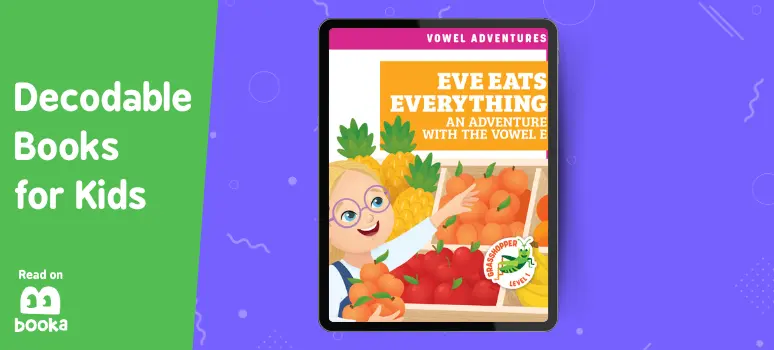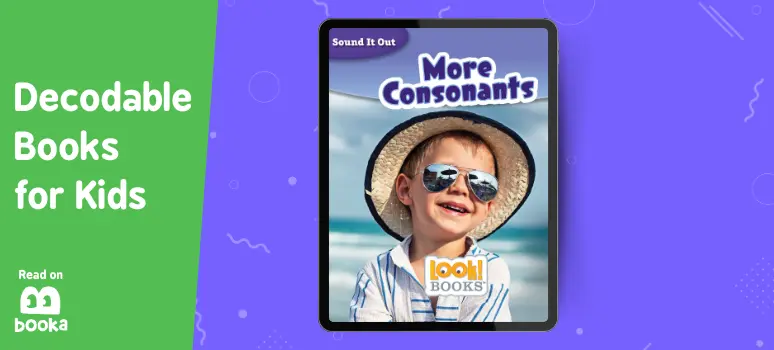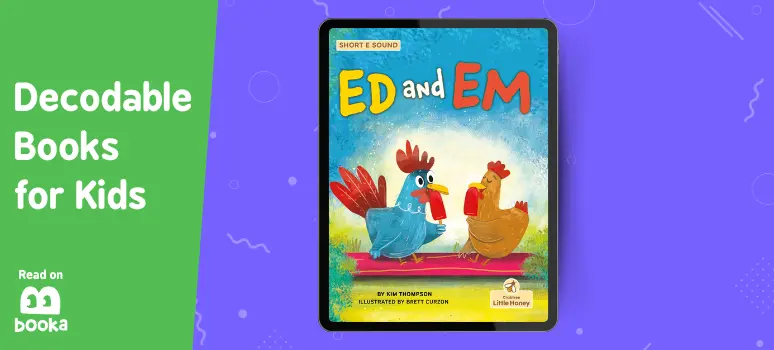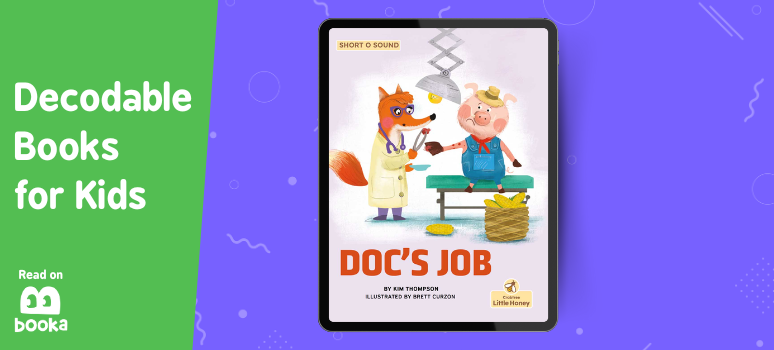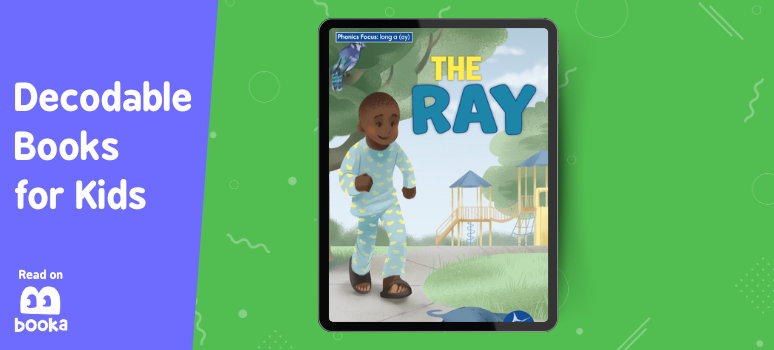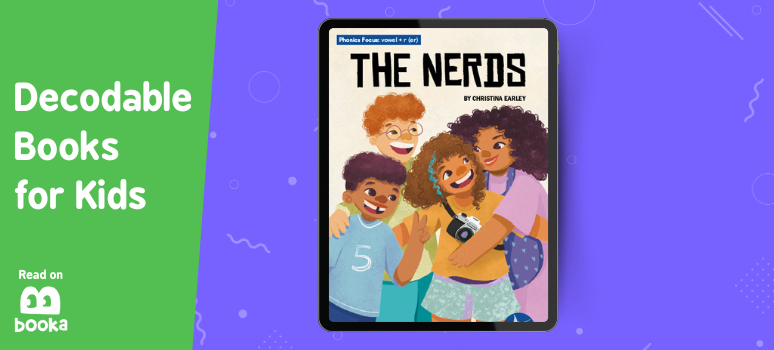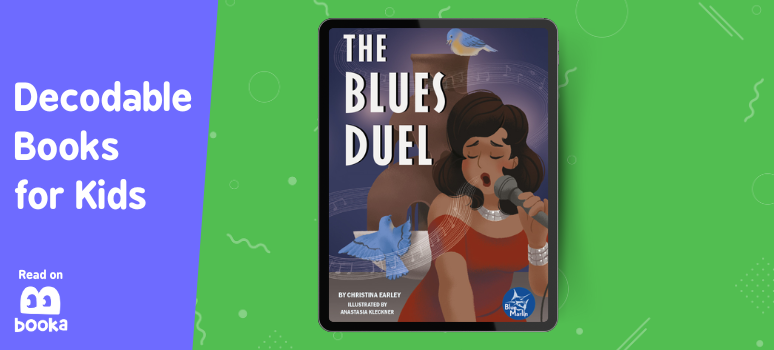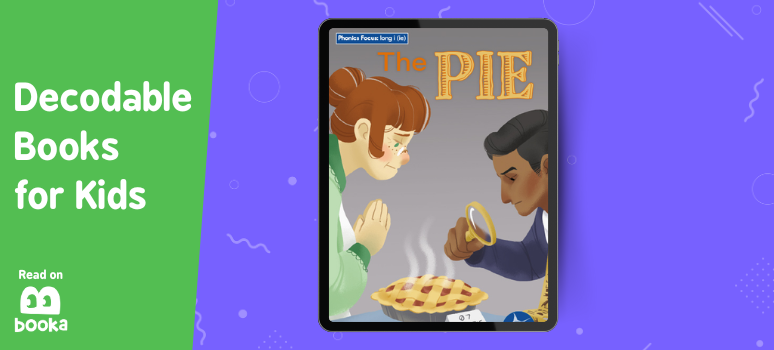Decodable books are essential literacy tools that promote early reading skills by introducing phonics principles. These carefully crafted books contain controlled vocabulary, allowing young readers to apply their knowledge of letter-sound relationships to decode words and sentences. As a parent or guardian, understanding the significance of decodable books and having access to quality titles can help you nurture a proficient reader.
In this article, we explain what decodable texts are and why they're critical for emerging readers. We also share a curated list of the twelve best decodable books for kids, including where to find these titles.
Ready to learn all about decodable stories? Let's get into it!
Content Quick Links:
What are the benefits of decodable texts?
Decodable Books vs Leveled Readers
How do I choose decodable texts?
What are decodable books?
Decodable books are books designed to help young readers practice specific letter-sound correlations (also known as GPCs or grapheme-phoneme correspondences). In other words, decodable texts help early readers learn to match phonemes (letter sounds) and graphemes (written representations of sounds).
Decodable texts focus on simple phonics patterns a child has previously learned, allowing them to practice decoding words using their phonics knowledge. For example, a decodable book may focus on the short ‘A’ sound (/æ/) and contain a sentence like - “The fat cat had a hat.” In this case, the young reader can practice identifying the /æ/ sound in each word - the f/æ/t c/æ/t h/æ/d /æ/ h/æ/t.
INTERESTING TO NOTE: 64% or more of the words in a book must be identifiable using phonics knowledge to be considered a decodable book!
Benefits of Decodable Texts
Decodable texts are great tools for early readers (and struggling readers) because the words are designed to be easy to decode. In addition to this, decodable books offer the following benefits.
- Help children master newly learned phonics skills (and sight words)
- Allow early readers to practice segmenting and blending
- Help children develop the ability to recognize words quickly and effortlessly, promoting fluency and automaticity
- Facilitate independent reading success
- Serve as an essential stepping stone to more challenging books
- Boost reading confidence, helping children find joy in reading
A study by Wiley Blevins confirmed the effectiveness of decodable books in promoting early literacy skills and reading enjoyment. Wiley found that the number of children in a control group who disliked reading decreased (from 14% to just 3%) as a result of reading decodable texts. He attributed this improvement to the sense of confidence children felt when reading decodable stories.
As you can see, using decodable books is one of the best ways to promote early reading skills and practice phonics at home!
Looking for more tips on teaching phonics? Check out this article - Teaching Phonics at Home.
Decodable Books vs Leveled Readers
Many parents wonder - what is the difference between decodable books vs leveled readers? Here’s what you need to know.
Decodable books target phonics patterns and high-frequency words a child has previously learned. The main focus of these books is to help children practice decoding. Decodable texts repeat the pattern throughout the story to help kids practice decoding a particular letter-sound correlation.
Whether or not a particular decodable text is suitable for a child depends on whether they have learned that specific phonics pattern. If they have learned the pattern used in the book, then the book is suitable. If not, the pattern should be learned before reading the story.
On the other hand, leveled readers (often referred to as predictable texts) are books that incorporate high-frequency words and predictable sentence structures. They may also include rhymes and pictures that emphasize meaning to help make the words easier to read and comprehend. Therefore, young readers don't have to rely solely on their decoding skills to read leveled readers - unlike with decodable books.
Predictable texts are rated on a difficulty scale. This scale considers elements such as the number and length of words, the difficulty of the vocabulary and sentence structure, etc. A leveled reader is suitable for a child if it matches their reading level.
KEY TAKEAWAY: The main difference between decodable books and leveled readers is that decodable texts focus on one particular phonics pattern. In contrast, leveled books may include numerous sound patterns and a range of vocabulary and sentence structures.
Using Decodable Books vs Leveled Readers
Decodable books are best for early readers - most commonly, children in kindergarten to grade 2. That said, decodable stories can also be helpful for struggling readers and English language learners. When selecting decodable texts for your child, choose stories that focus on phonics patterns they have already learned.
Leveled readers can be used throughout a child’s early reading journey - commonly throughout elementary school. To choose a leveled book for your child, you must know their reading level. Be sure to match the level of the reader with your child’s reading level.
It is important to note that leveled readers don’t provide young readers with sufficient decoding practice. These types of books use various words that are not always easily decoded. Therefore, young readers may get into a habit of guessing unknown words rather than sounding them out. As a result, decodable books are more helpful for teaching early reading strategies.
Choosing Decodable Texts
What are important qualities to look for when selecting a decodable story for your child? Here are some tips for choosing decodable texts.
- Ensure your child has learned about the phonics pattern(s) used in the book.
- Verify that the book uses consistent phonics patterns that are repeated throughout.
- Look for decodable books that will enhance your child’s knowledge about the world.
- BONUS: Look for decodable stories that teach meaningful life lessons!
Ready to read some decodable books at home? Let’s look at some recommended stories that will help your child practice their phonics and reading skills!
The 12 Best Decodable Books
Below is a list of the best decodable books for kids!
To make it easier to choose the best decodable text for your child, we’ve separated the recommended books by grade. However, the most important factor when selecting a decodable book is that your child is familiar with the phonics patterns presented in it. Therefore, if your child’s grade and the recommended grade for the book do not match, no worries! Choose a book based on your child’s knowledge.
Decodable Books for Kindergarten
Here are some of the best decodable books for kindergarten kids. These stories include captivating topics and characters and phonics patterns commonly learned in kindergarten.
You can find all these books and more on the Booka reading app for kids!
1. Olivia Goes to the Zoo: An Adventure with the Vowel O
By Marie Brandle
In 'Olivia Goes to the Zoo,' early readers go on an exciting zoo adventure with Olivia and her mom and explore animals like lions, gorillas, koalas, and more! This decodable book for kindergarten examines the vowel 'O' and its various sounds and functions.
Phonics Focus: Sounds made by the vowel ‘O’.
2. Eve Eats Everything: An Adventure with the Vowel E
By Brandon Terrell
In ‘Eve Eats Everything,’ young readers follow Eve and Ed as they make their way through the grocery store, dreaming of eating the delicious foods they see. This fun decodable text examines the sounds and functions of the vowel ‘E.’
Phonics Focus: Sounds made by the vowel ‘E.’
BONUS: In addition to being a decodable story, this story includes a picture glossary to help support the development of new vocabulary.
By Wiley Blevins
In this decodable book, children explore the sounds of the most common consonants, including ‘B,’ ‘C,’ ‘D,’ ‘F,’ ‘L,’ ‘M,’ ‘N,’ ‘P,’ ‘R,’ ‘S,’ and ‘T.’ This book reinforces letter-sound associations and examines how these common consonants are combined with vowels to build words.
Phonics Focus: Common consonant sounds
4. Sound It Out: More Consonants
By Wiley Blevins
This decodable story, part of Wiley Blevins's consonant collection, examines the less common consonant sounds and functions. In ‘Sound It Out: More Consonants,’ children explore the consonants ‘G,’ ‘H,’ ‘J,’ ‘K,’ ‘Q,’ ‘V,’ ‘W,’ ‘X,’ ‘Y,’ and ‘Z’ and learn how to build words using these letters!
Phonics Focus: Less common consonant sounds.
Decodable Books for First Grade
Looking for decodable texts that will help your first grader practice their reading skills? Look no further! Below are some of the best decodable books for 1st grade.
You’ll find these stories and more on the Booka!
By Kim Thompson
‘Who Yaps Back?’ follows Jack the dog as he barks and plays in the yard. This story focuses on the short ‘A’ sound and is the perfect decodable book for first-grade readers.
Phonics Focus: Short ‘A’ sound combined with consonant letters.
BONUS: This story also includes high-frequency words to help children strengthen their reading skills.
6. Ed and Em
By Kim Thompson
In ‘Ed and Em,’ kids join two chickens on their farm adventures. This decodable story explores friendship using decodable text and high-frequency words.
Phonics Focus: Short ‘E’ sound.
7. Mike's Ride
By Kim Thompson
‘Mike’s Ride’ follows Mike, the pig, on his mission to take a ride! This decodable book
uses high-frequency words and fully decodable text to help first graders improve their reading abilities.
Phonics Focus: Long ‘I’ sound (i.e., I-consonant-E), short vowel/long vowel discrimination.
By Kim Thompson
In ‘Doc’s Job,’ children join Doctor Fox on her mission to heal others. This decodable book features high-frequency words and allows children to practice decoding the short ‘O’ sound.
Phonics Focus: Short ‘O’ sound.
BONUS: In addition to helping kids build their reading skills, ‘Doc’s Job’ introduces the concepts of empathy and compassion.
Decodable Books for 2nd Grade
Looking for decodable books for 2nd grade kids? Below are some recommended stories to help your child practice phonics and reading skills.
Explore these decodable texts and more on the Booka!
9. The Ray
By Christina Earley
In ‘The Ray,’ children join Adjatay as he searches for his lost Ray toy. Young readers help Adjatay find his toy while practicing words with the ‘ay’ sound.
Phonics Focus: Long ‘A’ sound (i.e., ‘ay’).
BONUS: This decodable book uses the Dyslexie font for better accessibility for people with reading difficulties like dyslexia. ‘The Ray’ also includes quizzes, activities, and helpful teaching tips for parents, caregivers, and teachers.
10. The Nerds
By Christina Earley
‘The Nerds’ follows a family (the Nerds) of experts as they share their individual interests. With this decodable text, early readers gain new knowledge while practicing reading words with the ‘er’ sound.
Phonics Focus: Vowel + ‘R’ sound (i.e., ‘er’).
BONUS: ‘The Nerds’ uses the Dyslexie font to make it easier to read for children with dyslexia. This decodable story also includes quizzes, activities, and teaching tips for parents, caregivers, and teachers.
11. The Blues Duel
By Christina Earley
In ‘The Blues Duel,’ children follow Sue and Lue as they sing in a blues duel. With the help of this story, young readers can see what it’s like to perform onstage and practice their phonics skills!
Phonics Focus: Long ‘OO’ sound (i.e., ‘ue’).
BONUS: Like Christina Earley’s other decodable books, ‘The Blues Duel’ uses the Dyslexie font for readers with dyslexia. The book also includes activities, quizzes, and teaching tips.
12. The Pie
By Christina Ealrey
In ‘The Pie’, kids meet Mie - a great pie baker preparing a pie for the Magpie Market Pie Challenge. Following Mie, kids will learn all about pie and phonics!
Phonics Focus: Long ‘I’ sound (i.e., ‘ie’).
BONUS: ‘This decodable text also uses the Dyslexie font to assist readers with dyslexia and includes teaching tips, activities, and quizzes.
Looking for decodable books for more advanced readers? The Blue Marlin Readers series (e.g., The Snow, The Pie, The Blues Duel, and others) are suitable for children in grades 2 to 6. You can find these stories and more on Booka!
Explore Booka’s Collection of Decodable Texts
Wondering where to find decodable books for your child? The Booka reading app for kids offers a vast collection of decodable texts, including the titles listed above.
Booka’s collection includes decodable stories suitable for early readers in kindergarten to grade 6.
Download Booka today to get access to our collection of decodable books, plus:
- A wide selection of audiobooks for kids
- Winter picture books for young readers
- Read along books for kids
- Preschool read aloud books
- Read aloud books for kindergarten
- First day of school books
- Books about life lessons and more

